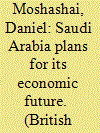|
|
|
Sort Order |
|
|
|
Items / Page
|
|
|
|
|
|
|
| Srl | Item |
| 1 |
ID:
176556


|
|
|
|
|
| Summary/Abstract |
In response to a rapid decline in world oil prices, Saudi Arabia’s Crown Prince Mohammed Bin Salman introduced a new economic blueprint called Saudi Vision 2030 and the accompanying National Transformation Plan that would enable the Kingdom to diversify its heavily oil-dependent revenue base, reduce its growing budget deficits, balance its budgets, and promote long-term economic growth. This article analyses the goals of the Vision and the policies offered to achieve them, which entail significant reforms to the Kingdom’s fiscal and budgetary procedures and policies. This study considers the political and institutional challenges that confront the Saudi Vision and its likelihood of success.
|
|
|
|
|
|
|
|
|
|
|
|
|
|
|
|
| 2 |
ID:
171193


|
|
|
|
|
| Summary/Abstract |
If the lifting of the Saudi women’s driving ban on June 24, 2018 was so momentous, why did so few women embrace the opportunity to drive? Answers to this question are considered in the following pages, informed by two months of fieldwork (June–August 2018) in the Kingdom, during which interviews, participant observation, and the author’s own June 2018 driving experiences, reveal that despite the media hype, and the significance of the event, only a handful of women in Saudi Arabia are driving. Even more than a year after lifting the ban, it is still a novelty to see women driving in the Kingdom (Lulwa Shalhoub, “Saudi Arabia: My Experience as Female Driver: One Year On,” BBC News, June 24, 2019, https://www.bbc.com/news/world-middle-east-48661233).This article argues that the government’s new gender inclusive driving policy embodies a rebranding effort from the top, rather than responsiveness to Saudi women’s rights activism, or public opinion. The arrest of a number of Women2 Drive activists before June 24 sends a clear message that such changes are not the beginnings of an intended “pink revolution” (Ghazanfar Ali Khan, “Three Million Saudi Women on the Roads by 2020,” Arab News, June 24, 2018, http://www.arabnews.com/node/1326991/saudi-arabia). On the contrary, allowing women to drive fulfills several of Crown Prince Muhammad bin Salman’s immediate Vision 2030 goals for economic and social reform in the kingdom.The impact of a projected 3 million female drivers in the kingdom by 2030, however, will not only potentially “empower women” and “change the employment landscape of the country,” but also may result in a host of unintended consequences enabled by enhancing women’s access to capital, mobility and autonomy (Thomas Oriti and Laura Brierly Newton, “Women in Saudi Arabia Have a Long Way to Go in Order to Be Free, Says Manal al Sherif,” ABC News, February 11, 2018, https://www.abc.net.au/news/2018-02-08/saudi-women-revolution-has-a-long-way-to-go-says-manal-al-sharif/9396306, accessed online November 29, 2018). The biggest barrier to women’s advancement in the Kingdom, nonetheless, is the guardianship law, not the inability to drive a car.
|
|
|
|
|
|
|
|
|
|
|
|
|
|
|
|
|
|
|
|
|